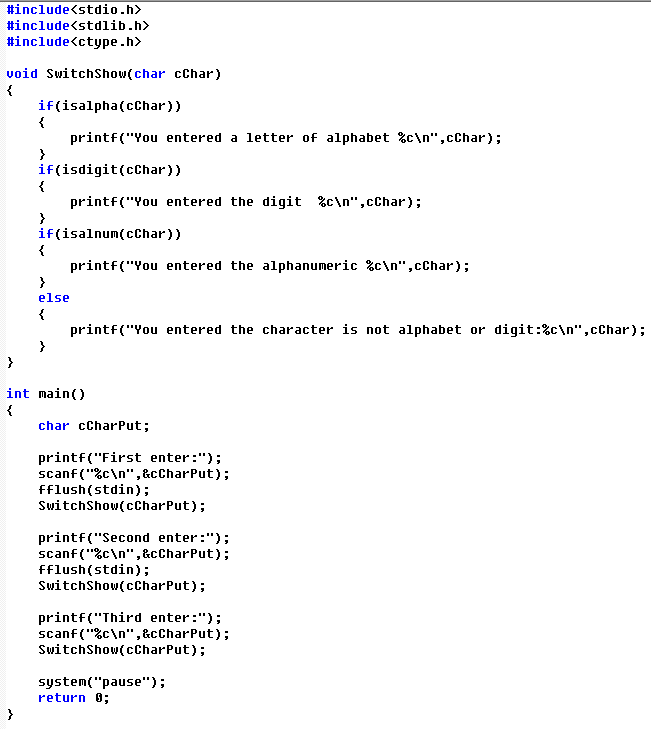fflush(stdin)是一個計算機專業術語,功能是清空輸入緩衝區,通常是為了確保不影響後面的數據讀取(例如在讀完一個字元串後緊接著又要讀取一個字元,此時應該先執行fflush(stdin);)。

fflush(stdin)
相關詞條
- fflush(stdin)
fflush(stdin)是一個計算機專業術語,功能是清空輸入緩衝區,通常是為了確保不影響後面的數據讀取(例如在讀完一個字元串後緊接著又要讀取一個字元,此時應該先執行...
- fflush
fflush是一個計算機函式,功能是沖洗流中的信息,該函式通常用於處理磁碟檔案。fflush()會強迫將緩衝區內的數據寫回參數stream 指定的檔案中。...
- stdin
stdin是標準輸入 std即standard(標準),in即input(輸入),合起來就是標準輸入。 ...在scanf函式使用fflush(stdin);,清空輸入緩衝區:#include<bits/srdc++.h> int...
- 鞍點
fflush(stdin);}else if( (*pm<=0 || *pm>=10) && (*pn<=0) || (*pn>=10) ){flag = TRUE;printf("Enter Big or small,retry!\n");}...
- IF(計算機中的指令)
printf("%d",y);fflush(stdin);getchar();}3 if(表達式1)語句1else if (表達式2)語句2else if (表達式3) 語句3……else if (語句m) 語句...
- scanf(計算機語言函式)
有上述問題可知,當使用scanf函式時,如果遇到一些匪夷所思的問題,在scanf函式後正確使用fflush(stdin);,清空輸入緩衝區,可以解決很多問題。以本題為例:...
- 你必須知道的495個C語言問題(2016年人民郵電出版社出版...
用fflush(stdin) 可以嗎? 143打開和操作檔案 14412.29 我寫了一個函式用來打開檔案:myfopen(char *filename, FILE *fp){fp = fopen(filename, "r");}可...
- 你必須知道的495個C語言問題(2009年人民郵電出版社出版...
用fflush(stdin)可以嗎?打開和操作檔案12.29 我寫了一個函式用來打開檔案:myfopen(char*filename,FILE*fp){fp=fopen(filename,"r");}可我這樣調用的時候:...
- 馬踏棋盤
fflush(stdin);scanf("%c%d,%d%c",&a,&k,&j,&b);t.i=k;t.j=j;printf("馬兒走的路線為\n");horsesteps(Board,t);}...
- IF
fflush(stdin); getchar(); } 3 if(表達式1)語句1 else if (表達式2)語句2 else if (表達式3) 語句3 …… else if (語句m) 語句 else 語句n (if的...
- 卡布列克運算
fflush(stdin);for(i=0;i<4;i++)num[i]=(int)(number/pow(10.0,(double)i))%10;for(i=0,flag=1;i<3;i++){for(j=i+1;j<4;j++)if(num...
- 逆鄰接表
()來接收換行符,也可用fflush(stdin)清空輸入快取區 for(i=0;i<ALG->vexnum;i++){ printf("Please input %dth vex(char):",(i+1)); scanf("%c",...
- 孩子鍊表示法
("輸入第 %d 個節點的值:\n",i+1); fflush(stdin); scanf("%c",&(tree.nodes[i].data)); tree.nodes[i].firstchild=(ChildPtr*)malloc(sizeof(...
- setlinebuf
is read from any stream attached to a terminal device (typicallystdin). The functionfflush(3)may be used to force the block out early. (See fclose...
- C語言循環控制語句
}fflush(stdin);printf("請選擇繼續y或者離開n\n");yn=getch();}}參考資料 1. C語言do-while語句的用法 .C語言中文網[引用日期2015-11-04] ...
- 同構數
fflush(stdin);select=getch();}do{printf("how many numbers ?\n");fflush(stdin);scanf("%d",&max);}while(max>=65536 || max<0);if(max)...
- cin(C++語言中的標準輸入設備)
(); fflush(stdin); cin.clear(); cin.ignore(次數,'需要結束的字元(這兒就是\n)');//一般次數取得足夠大讓結束符起作用,如cin.ignore(6,'a'); cout<...
